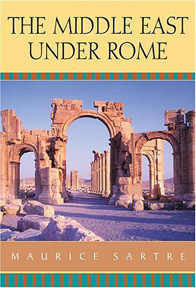Multimedia Reference Religion Travel |
 The Middle East Under Rome Maurice Sartre Translated by Catherine Porter and Elizabeth Rawlings
Description From The Publisher: The ancient Middle East was the theater of passionate interaction between Phoenicians, Aramaeans, Arabs, Jews, Greeks, and Romans. At the crossroads of the Mediterranean, Mesopotamia, and the Arabian peninsula, the area dominated by what the Romans called Syria was at times a scene of violent confrontation, but more often one of peaceful interaction, of prosperous cultivation, energetic production, and commerce--a crucible of cultural, religious, and artistic innovations that profoundly determined the course of world history. Maurice Sartre has written a long overdue and comprehensive history of the Semitic Near East (modern Syria, Lebanon, Jordan, and Israel) from the eve of the Roman conquest to the end of the third century CE and the dramatic rise of Christianity. Sartre's broad yet finely detailed perspective takes in all aspects of this history, not just the political and military, but economic, social, cultural, and religious developments as well. He devotes particular attention to the history of the Jewish people, placing it within that of the whole Middle East. Drawing upon the full range of ancient sources, including literary texts, Greek, Latin, and Semitic inscriptions, and the most recent archaeological discoveries, "The Middle East under Rome will be an indispensable resource for students and scholars. This absorbing account of intense cultural interaction will also engage anyone interested in the history of the Middle East. Reviews This book is not merely a translation of Sartre's 1196-page volume, published in France in 2001 as "D'Alexandre เ Z้ nobie: " Histoire du Levant antique, IV e "si่ cle av. " "J.-C. -III" e "si่ cle apr. J.-C." Instead, this condensed edition -368 pages (with about 300 pages of abbreviations, notes, works cited, and index) -focuses on the Middle East during Roman times and features a new first chapter that provides crucial historical context. The text provides much more than a historical perspective, addressing issues of civic and rural life, such as the creation of colonies, land tenure and use, urban and economic development, indigenous cultures, and successions of various religions. Sartre (ancient history, Univ. of Tours, France) is a well-known authority on this subject, and though his extensive and highly scholarly work could prove challenging for a more general audience, it is sure to please researchers and educators, but strongly recommended for academic libraries. Ethan Pullman, Library Journal (Friday , April 01, 2005), Univ. of Pittsburgh Lib. Copyright 2005 Reed Business Information Histories of the Roman Empire tend to stay close to Rome, so Sartre's summation of what we know about imperial influence in the region then known as Syria is highly welcome. Though the book's heft could be intimidating (and this is but a chunk of a much larger book published in France a few years ago), footnotes and bibliography account for nearly 300 pages, and the main text is skillfully rendered into accessible, almost conversational English. Sartre, a professor of ancient history at the University of Tours, offers an account of major events in the region, but the real treasure is the rich detail about ancient Syria's cultural life. Drawing on archeological evidence as well as historical texts, the author sketches a thriving region dotted by cosmopolitan city-states that were in many cases governed by local rulers with Roman guidance. Sartre traces the early rise of Christianity and the upheaval of the Jewish community following a failed rebellion in A.D. 66 -74, placing them within the broader context of a generally "adaptable and flexible" imperial leadership that allowed cultural diversity to flourish so long as Rome received its tribute. Vivid descriptive prose could help this excellent treatise find a readership beyond the world of classical scholars. 43 b& w illus., 2 maps. "(Apr.)" Publisher's Weekly, Copyright 2005 Reed Business Information. Reader's Index Send us your favorite quotes or passages from this book. About the Author Maurice Sartre is Professor of Ancient History, University of Tours and the Institut Universitaire de France. Table of Contents
Customer Reviews Write your own online review. Look for Similar Books by Subject
| |||||||||||||||||||||||||||||||||||||||||||||||||||||||||||||||||||||||||||||||||||||||||||||||||||||||||||||||||||||||||||||||||||||||||||||||||||||||||||||||||||||||||
Copyright ©1996-2010 CenturyOne Bookstore. All Rights Reserved. All prices subject to change and given in U.S. dollars. Your purchase from CenturyOne.com will assist the CenturyOne Foundation in providing funding for various archaeological and research projects which seek to provide more information about the period of the First Century C.E., the origins of Christianity and the world of the Bible in general. All materials contained in http://www.centuryone.com are protected by copyright and trademark laws and may not be used for any purpose whatsoever other than private, non-commercial viewing purposes. Derivative works and other unauthorized copying or use of stills, video footage, text or graphics is expressly prohibited. |

